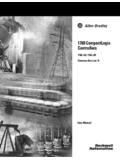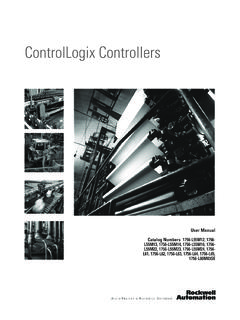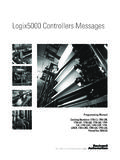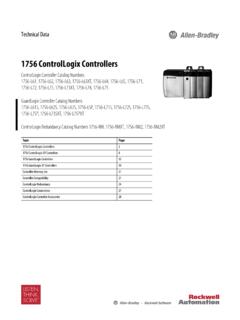Transcription of Logix5000 Controllers Add-On Instructions Programming …
1 Logix5000 Controllers Add-On Instructions Programming manual Catalog Numbers 1756 controllogix , 1768 CompactLogix, 1769. CompactLogix, 1789 SoftLogix, 1794. FlexLogix, PowerFlex 700S with DriveLogix Important user Information Solid state equipment has operational characteristics differing from those of electromechanical equipment. Safety Guidelines for the Application, Installation and Maintenance of Solid State Controls (publication available from your local Rockwell Automation sales office or online at ) describes some important differences between solid state equipment and hard- wired electromechanical devices. Because of this difference, and also because of the wide variety of uses for solid state equipment, all persons responsible for applying this equipment must satisfy themselves that each intended application of this equipment is acceptable. In no event will Rockwell Automation, Inc.
2 Be responsible or liable for indirect or consequential damages resulting from the use or application of this equipment. The examples and diagrams in this manual are included solely for illustrative purposes. Because of the many variables and requirements associated with any particular installation, Rockwell Automation, Inc. cannot assume responsibility or liability for actual use based on the examples and diagrams. No patent liability is assumed by Rockwell Automation, Inc. with respect to use of information, circuits, equipment, or software described in this manual . Reproduction of the contents of this manual , in whole or in part, without written permission of Rockwell Automation, Inc., is prohibited. Throughout this manual , when necessary, we use notes to make you aware of safety considerations. Identifies information about practices or circumstances that can cause an explosion in a WARNING.
3 Hazardous environment, which may lead to personal injury or death, property damage, or economic loss. IMPORTANT Identifies information that is critical for successful application and understanding of the product. Identifies information about practices or circumstances that can lead to personal injury or death, ATTENTION. property damage, or economic loss. Attentions help you identify a hazard, avoid a hazard, and recognize the consequence SHOCK HAZARD Labels may be on or inside the equipment, for example, a drive or motor, to alert people that dangerous voltage may be present. BURN HAZARD Labels may be on or inside the equipment, for example, a drive or motor, to alert people that surfaces may reach dangerous temperatures. Allen-Bradley, Rockwell Automation, and TechConnect are trademarks of Rockwell Automation, Inc. Trademarks not belonging to Rockwell Automation are property of their respective companies.
4 Table of Contents Preface Purpose of this manual .. 5. How to Use this manual .. 5. Chapter 1. Designing Add-On Instructions Introduction .. 7. What are the Parts of an Add-On Instruction Definition? .. 8. General Information .. 8. Parameters .. 9. Local Tags .. 9. Data Type.. 9. Logic Routine.. 10. Optional Scan Mode Routines .. 11. Change History .. 11. Help .. 11. Deciding to Develop an Add-On Instruction.. 12. Instruction Functionality .. 12. Encapsulation.. 12. Available Languages.. 13. Instruction Size .. 13. Runtime Editing of Functionality .. 13. Nesting Add-On Instructions .. 13. Using a Routine Versus an Add-On Instruction .. 14. Programmatic Access to Data .. 15. Unavailable Instructions within Add-On Instructions .. 16. Planning the Design of an Add-On Instruction .. 18. Developing an Add-On Instruction .. 18. Creating an Add-On Instruction .. 20. Considerations when Selecting a Language for an Add-On Instruction.
5 21. Transitional Instructions .. 21. Create Parameters.. 22. Motor Starter Parameters Tab.. 24. Deadtime and Lag Simulation Parameters Tab .. 25. Considerations When Passing Arguments to Parameters by Reference or by Value .. 25. Considerations for Selecting a Data Type for a Parameter .. 26. Consideration when Using Single Dimension Array as InOut Parameter .. 26. Determining Which Parameters to Make Visible or Required.. 26. Simulation Instruction in Function Block .. 27. Simulation Instruction in Ladder .. 27. 1 Publication 1756-PM010B-EN-P - July 2008 1. Table of Contents Create Local Tags .. 28. Motor Starter Local Tags.. 30. Deadtime and Lag Simulation Local Tags Tab .. 30. Enter the Logic of the Add-On Instruction .. 31. Add-On Instructions Execution Considerations .. 31. Optimizing Performance Considerations .. 31. Defining the Operation of an Instruction in Different Scan Modes.
6 32. Enabling Scan Modes.. 33. Prescan Routine .. 33. Postscan Routine .. 35. EnableInFalse Routine .. 37. Using the EnableIn and EnableOut Parameters.. 38. EnableIn Parameter and Ladder Diagram .. 39. EnableIn Parameter and Function Blocks .. 39. EnableIn Parameter and Structured Text .. 39. Testing the Add-On Instruction .. 40. Before You Test.. 40. Test the Flow .. 40. Monitor Logic with Data Context Views .. 40. Tips for Validating the Add-On Instruction in Different Scan Modes 42. Storing Your Instructions .. 42. Do You Want to Store Many Add-On Instructions That Share a Set of Common Add-On Instructions or user -Defined Types in a Common Location? .. 43. Do You Want to Distribute an Add-On Instruction Definition as One File or to Manage Each Add-On Instruction as a Stand-alone Definition? .. 44. Updating an Add-On Instruction to a Newer Revision .. 45. Defining Source Protection for an Add-On Instruction.
7 48. Applying Source Protection .. 48. Enable the Source Protection Feature .. 49. Apply Source Protection .. 49. Observe Source Protection .. 52. 2 Publication 1756-PM010B-EN-P - July 2008. Table of Contents Creating Instruction Help .. 53. Define the Documentation for Add-On Instructions .. 53. Write Clear Descriptions .. 53. Document an Add-On Instruction .. 55. Language Switching .. 57. Motor Starter Instruction Example .. 58. Motor Starter Ladder Diagram .. 60. Motor Starter Function Block Diagram .. 60. Motor Starter Structured Text.. 60. Simulation Instruction Example .. 61. Ladder Diagram Configuration .. 62. Function Block Diagram Configuration .. 63. Structured Text Configuration .. 63. Chapter 2. Using an Add-On Instruction Introduction .. 65. Programming Tips when Using an Add-On Instruction .. 69. Programmatically Accessing a Parameter .. 70. Using the Jog Command in Ladder Diagram.
8 71. Using the Jog Command In Function Block Diagram .. 71. Using the Jog Command in Structured Text .. 73. Monitoring the Value of a Parameter .. 73. View Logic and Monitor with Data Context .. 74. Is the Add-On Instruction Source Protected? .. 76. Copying an Add-On Instruction Definition .. 77. Importing an Add-On Instruction Definition .. 78. Exporting an Add-On Instruction Definition .. 79. Publication 1756-PM010B-EN-P - July 2008 3. Table of Contents 4 Publication 1756-PM010B-EN-P - July 2008. Preface Purpose of this manual This manual shows how to design, configure, and program Add-On Instructions . This manual is one of a set of related manuals that show common procedures for Programming and operating Logix5000 Controllers . For a complete list of common procedures manuals, see the Logix 5000 Controllers Common Procedures Programming manual , publication 1756-PM001.
9 The term Logix5000 controller refers to any controller that is based on the Logix5000 operating system, such as: CompactLogix Controllers controllogix Controllers DriveLogix Controllers FlexLogix Controllers SoftLogix5800 Controllers How to Use this manual Some text is formatted differently from the rest of the text. Text that is Identifies For example Means Italic the actual name of an item that you Right-click user -Defined Right-click the item that is named see on your screen or in an example user -Defined. courier information that you must supply Right-click You must identify the specific program in based on your application (a name_of_program your application. Typically, it is a name or variable) variable that you have defined. enclosed in brackets a keyboard key Press [Enter]. Press the Enter key. Publication 1756-PM010B-EN-P - July 2008 5. Preface Notes: 6 Publication 1756-PM010B-EN-P - July 2008.
10 Chapter 1. Designing Add-On Instructions Introduction Add-On Instructions are available beginning with RSLogix 5000 version 16. software. Add-On Instructions are custom Instructions that you design and create. With Add-On Instructions , you can create new Instructions for sets of commonly-used logic, provide a common interface to this logic, and provide documentation for the instruction. Add-On Instructions are intended to be used to encapsulate commonly used functions or device control. They are not intended to be a high-level hierarchical design tool. Programs with routines are better suited to contain code for the area or unit levels of your application. These are some benefits to using an Add-On Instruction. Reuse code You can use Add-On Instructions to promote consistency between projects by reusing commonly-used control algorithms. If you have an algorithm that will be used multiple times in the same project or across multiple projects, it may make sense to incorporate that code inside an Add-On Instruction to make it modular and easier to reuse.









